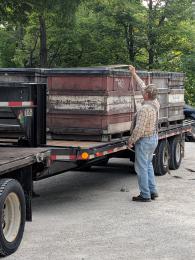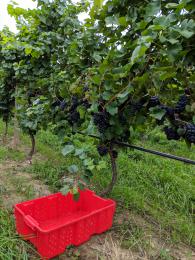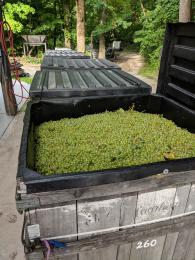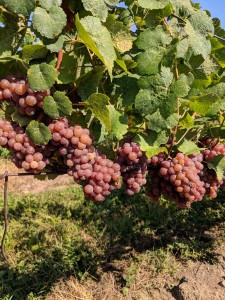2018 Harvest Update: September 28
In our local vineyards, we are still looking at a vintage of very good quality. For the most part, the weather has been relatively hot to this point, but the last few days have the temperature dipping into the low 50’s/high 40’s in the night, with daytime highs in the 60’s. The air and even the clouds have changed, bringing that crisp clarity of autumn that is so typical this time of year. We’ve avoided the rains so far that have adversely affected many Eastern vineyards. We’re a little over halfway through harvest now, and what is left is mostly red varieties, plus the late-season whites, Vidal and Catawba. Cabernet Franc and Carmine are nearly ready, and we’ll let them hang as long as the wea ther lets us. With cooler temperatures, we’ll need ample sunlight to continue the ripening process, developing the desired flavors in the fruit. Rain is in the forecast, and it will now be a dance with the weather to determine to the right time for harvesting these late-season varieties.
ther lets us. With cooler temperatures, we’ll need ample sunlight to continue the ripening process, developing the desired flavors in the fruit. Rain is in the forecast, and it will now be a dance with the weather to determine to the right time for harvesting these late-season varieties.
The harvest news has not been so good this year for vineyards on the other side of our state. I had the opportunity to spend a day at several vineyards in southeastern Pennsylvania last week. We often talk about the Pennsylvania wine industry as a single entity, but it is, in reality, quite diverse. This is a big state, and the growing conditions (terroir, if you will) vary greatly from one part of the state to the next, and this has played out in a big way this year. Pinot Noir was being harvested while I was there, and the incessant rain the region had during the growing season has taken its toll on the crop—heavy Botrytis and rot had set in. The leaves had also been infected with mildew, reducing their photosynthesis ability and ultimately, the ability of the vine to ripen fruit. The result was that a good portion was dropped to the ground as not fit for wine. As if this was not enough, that area is also dealing with the spotted lanternfly, an invasive species that came into that area from China and can severely damage a vineyard (among other things). The accompanying photo shows it all: dead leaves from mildew; rotten, heavily Botrytised fruit; and a (dead) lanternfly.
What is most remarkable about this season are the responses of the vineyard managers and winemakers to these factors that are clearly beyond their control. All efforts were, of course, made in the vineyard to minimize the damage from each of these events—appropriate sprays, pruning, and culling of the fruit at harvest—and the intent of the winemaker is still to make the best wine possible, adapting the process to produce the style of wine that reduces the problems and highlights the good. Hats off to these people as they are put to task to make the most out of a very troublesome vintage. The skill of Eastern winemakers who routinely produce good and interesting wines while negotiating difficult conditions and challenges their western counterparts seldom see is highly underrated.
To find information about identifying the spotted lanternfly, current information about where it is known to exist, quarantine order, and compliance go to the Pennsylvania Department of Agriculture’s Spotted Lanternfly page.
Bob Green
PIWC Executive Winemaker






